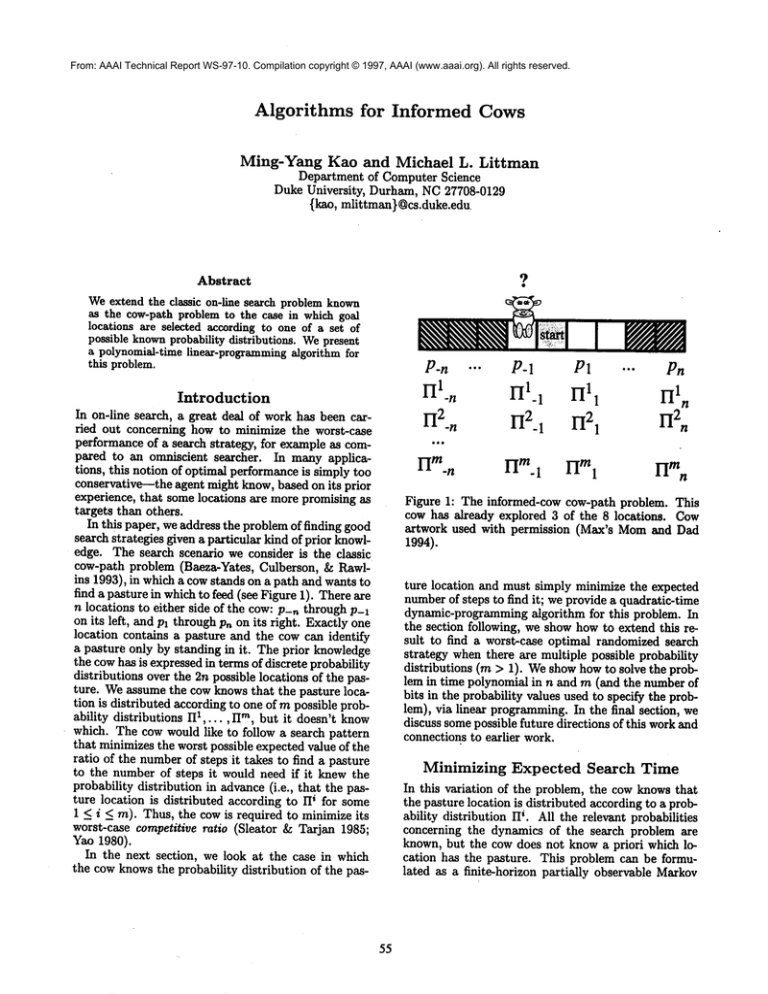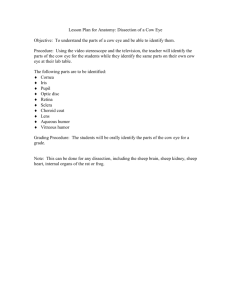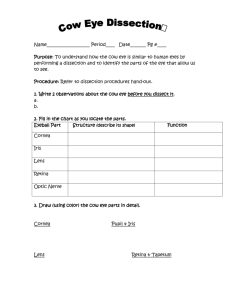
From: AAAI Technical Report WS-97-10. Compilation copyright © 1997, AAAI (www.aaai.org). All rights reserved.
Algorithms
for
Informed
Cows
Ming-Yang Kao and Michael L. Littman
Department of Computer Science
Duke University, Durham, NC 27708-0129
{kao, mlittman} @cs.duke.edu
?
Abstract
We extend
theclassic
on-line
searchproblem
known
as thecow-path
problem
to thecasein whichgoal
locations
areselected
according
to oneofa setof
possible
knownprobability
distributions.
We present
a polynomial-time
linear-programming
algorithm
for
thisproblem.
Introduction
In on-line search, a great deal of work has been carried out concerning how to minimize the worst-case
performance of a search strategy, for example as compared to an omniscient searcher. In many applications, this notion of optimal performance is simply too
conservative---the agent might know, based on its prior
experience, that some locations are more promising as
targets than others.
In this paper, we address the problem of finding good
search Strategies given a particular kind of prior knowledge. The search scenario we consider is the classic
cow-path problem (Baeza-Yates, Culberson, & Rawlins 1993), in which a cow stands on a path and wants to
find a pasture in which to feed (see Figure 1). There are
n locations to either side of the cow: P-n through P-1
on its left, and Pl through Pn on its right. Exactly one
location contains a pasture and the cow can identify
a pasture only by standing in it. The prior knowledge
the cowhas is expressed in terms of discrete probability
distributions over the 2n possible locations of the pasture. Weassume the cow knows that the pasture location is distributed according to one of m possible probability distributions HI,... ,II m, but it doesn’t know
¯ which. The cow would like to follow a search pattern
that minimizes the worst possible expected value of the
ratio of the number of steps it takes to find a pasture
to the number of steps it would need if it knew the
probability distribution in advance (i.e., that the pasture location is distributed according to II ~ for some
1 < i < m). Thus, the cow is required to minimize its
worst-case competitive ratio (Sleator & Tarjan 1985;
Yao 1980).
In the next section, we look at the case in which
the cow knowsthe probability distribution of the pas-
P-n ""
1-II.n
P-1
Pl
H1.1
Hll
1-I2_n
1"I2.1
1"I21
...
Pn
Hln
I’I2n
**o
m
ri -n
i-[m
- 1 rim 1
rimn
Figureh The informed-cow
cow-pathproblem.This
cow hasalreadyexplored3 of the 8 locations.
Cow
artworkused withpermission
(Max’sMorn and Dad
1994).
ture location and must simply minimize the expected
numberof steps to find it; we provide a quadratic-time
dynamic-programming algorithm for this problem. In
the section following, we show how to extend this result to find a worst-case optimal randomized search
strategy when there are multiple possible probability
distributions (m > 1). Weshow howto solve the problem in time polynomial in n and m (and the number of
bits in the probability values used to specify the problem), via linear programming.In the final section, we
discuss somepossible future directions of this work and
connections to earlier work.
Minimizing Expected Search Time
In this variation of the problem, the cow knows that
the pasture location is distributed according to a probability distribution IIi. All the relevant probabilities
concerning the dynamics of the search problem are
known, but the cow does not know a priori which location has the pasture. This problem can be formulated as a finite-horizon partially observable Markov
55
decision
process(POMDP) and solvedusingstandard
methods(Kaelbling,
Littman,
& Cassandra
1995).
Standardexactalgorithms
for POMDPS workin the
spaceof information
states
of thesearcher;
theseinformation
statessummarize
thishistory
of thesearch
process
as a probability
distribution
overtheunderlyingstates
(inthiscase,
thecross
product
oflocations
of
thecowandlocations
of thepasture).
Unfortunately,
theproblem
of solving
finite-horizon
partially
observableMarkovdecision
processes
is PSPACE-hard
(Papadimitriou
& Tsitsiklis
1987)in general,
so a generalpurposePOMDPsolverwouldprobablynot be appropriate
forthisproblem.
The particular
POMDPfor the informed-cow
cowpathproblem
hasa greatdealof additional
structure
thatmakestheuseof a general-purpose
algorithm
unnecessary.
In particular,
thesituations
in whichthe
cowneedsto makea decision
canbe represented
in an
extremely
efficient
way:(l,r,s) where£ isthenumber
ofexplored
locations
totheleftofthestarting
location,
r isthenumber
ofexplored
locations
totheright
of the
starting
location,
ands is 0 if thecowis currently
on
theleftsideoftheexplored
region
and1 ifthecowis
currently
ontherightsideof theexplored
region.
Usingthissituation
notation,
thecow’sinitial
situation
is(0,0,0)(or(0,0,1),
equivalently),
andthesituation
depicted
in Figure
1 is (1,2, 0).Theeffect
of moving
totheleftfrom(£,r, s) isto either
findthepasture
inlocation
P-(t+1)
ortomovetosituation
(£ + 1,r,
(ift < n),andtheeffect
of moving
to therightis
either
findthepasture
in location
P(r+x)
or tomove
situation
(£,r + I,i)(ifr <
Givena situation
(£,r,s),
we can computean information
statequiteeasily.We knowthe cowis at
location
P-tO-s)+rO)
(i.e.,
theextreme
leftor extreme
rightsidedepending
on s of theexplored
region),
and
theprobability
thatthepasture
is in location
pj is
II~/Pi(£, r, s) where
-(t+l)
j*.~--n
n
(1)
j=r+l
The function yi(t, r, s) represents the probability that
the pasture is not found in a search that leaves the cow
in situation (t, r, s).
There are several properties of the informed-cow
cow-path problem that justify this situation representation. First, the first time a location is visited, either
the cowdiscovers the pasture and the search ends, or it
discovers that the pasture is elsewhere, and the search
continues. This implies that while the cow is searching, all locations are either knownto be pasture-free
or presently unexplored. Second, the linear nature of
the path means that the explored locations will form a
contiguous region around the starting location. Third,
given that the cow is at one end of the explored region,
it can choose to moveto the left or to the right. If it
movesinto the explored region, its only rational course
(0,0,0)
(1,0,0)
(2,0,0)
(1,l,l)
(0,1,1)
(1,1,O)
(3,0,0) (2,1,1) (2,1,0)
(0,2,1)
(1,2,1) (1.2,0) (0,3,1)
(3,1,1) (3,1,0) (2,2,1) (2,2,0) (1,3,1) (1,3,0)
(3,2.1) (3.2.0) (2,3,1) (2.3.0)
(3,3,1) (3,3,0)
Figure 2: Relationship between the possible situations
for n -- 3 arranged as a situation DAG.
of action is to continue moving in the same direction
until it reaches the opposite edge of the explored region; turning around midstream is wasteful because it
provides no additional information and uses steps.
The set of reachable situations can be arranged into
a directed acyclic graph, called the situation DAG,illustrated in Figure 2. The expected number of steps
to the pasture from a given situation can be computed by considering the two choices, left and right.
If the cowchooses to go left from situation (£, r, s),
will find the pasture in the next step with probabili (l,r,s) and with the remainity II_(t+x)(x_R)+r(s)/u
~
ing probability, it will enter situation (£ + 1,r,0).
is a simple matter to compute the expected number
of steps from these quantities as a function of the expected numberof steps from situation (£ + 1, r, 0) (this
can be computed recursively). Similarly, we can compute the expected numberof steps to the pasture given
that the cow movesright from (l, r, s). The optimal expected numberof steps to the pasture from (l, r, s)
just the minimumover the expected number of steps
given an initial rightward step and an initial leftward
step.
To be a bit more concrete, we can find an optimal
search strategy for the cow by computing, for all situations (l, r, s),
OC(t,
r,s),
= d((t,r,s),l)+
vi(g,r,s)]V~((t+l,r,O))
f
QC(t,r, s),
= d((l,r,s),r)+
(1 ui(l,r,s)jV~((~,r+l,1))
V~((t,r,s)) = min(Q((l,r,s),l),Q((£,r,s),r))
(2)
where ui(l,r, s) is defined by Equation 1, and d is the
56
action-distance function defined by d((£, r, s), 1) =
£)s+1 and d((£, r, s), r) = (r+£)(1-s)+l. The
search strategy for the cowis, in situation (£, r, 8),
moveleft to an unexplored location if Q((£, r, s), 1)
Q((£, r, 8), r) and right otherwise.
The resulting algorithm computes optimal expected
numbers of steps for each situation in a bottom-up
fashion. Because the total number of situations is
O(n2), the run time of the algorithm is quadratic
case, the adversary can always place the pasture in the
last place the cow looks. On the other hand, if the
cow flips an unbiased coin to decide which direction
to movein first, the adversary cannot tell in advance
where the cow will search last. The worst-case competitive ratio for this randomizedstrategy is 2, because
the adversary is only able to force the cow to take 3
steps half the time and the rest of the time the cow
finds the pasture in a single step.
R.
Solution
Methodology
The problem of finding a search strategy to minimize
the worst-case competitive ratio is equivalent to a type
of two-player zero-sum game. The two players are
the cow and the adversary; the cow chooses a search
Strategy and the adversary chooses which of the m
probability distributions to use for the pasture location. There are efficient computational approaches to
solving many types of games including matrix games,
finite-horizon Markovgames, and incomplete
informationgametrees.We willshowthatthestandard
computational
approaches
fortheseproblems
do notapply
directlyto the informed-cow
cow-path
problem.The
remainder
of thesection
showsthata variation
of the
linear-programming
approachto incomplete
informationgametreescanbe usedto solvetheinformed-cow
cow-path
problemin polynomial
time.
Given
a search
strategy
andri~,itisnotdifficult
to
compute
thecompetitive
ratio.As a result,
theproblemof choosing
theoptimal
search
strategy
forthecow
can naturally
be castas a matrixgame(Owen1982).
In a matrixgame,thesetof alldeterministic
strategiesforone playercorresponds
to therowsof a matrix,andthesetof alldeterministic
strategies
forthe
otherplayercorresponds
to thecolumns.
Theentries
of thematrix
givethepayoff
to therowplayer
forplayingthecorresponding
strategies
against
oneanother.
Optimal
randomized
strategies
for eachplayercanbe
determined
usinglinearprogramming.
To applythe matrix-game
approach
to the informedcowcow-path
problem,
it is necessary
to enumerate
the
setof alldeterministic
search
strategies
forthecow;a
searchstrategy
is constructed
roughly
by assigning
a
choice
of "right"
or"left"
toeachofthepossible
situations.Because
eachof the0(2n2)deterministic
strategieswouldbe included
as a rowin the gamematrix,
thisapproach
is computationally
infeasible.
In finite-horizon
Markovgames,thepossibly
exponential-size
setof deterministic
strategies
isexpressed
compactly
by a setof separate
strategic
decisions
for
eachstateof the game.Theobviouscandidates
for
statesin the informed-cow
cow-path
problemare the
(l,r,8) situations.
As longas statesare"Markov"
(outcome
probabilities
areindependent
of thepast),
thistypeof gamecanbe solved
efficiently
viadynamic
programming
(Shapley
1953).Thiscanresultin exponential
savingsoverthematrix-game
approach
in the
casein whichactiondecisions
canbe madelocally
at
Minimizing the Worst-Case
Competitive
Ratio
In this section, we consider the problem of finding a
search strategy for the cow to minimize its worst-case
competitive ratio given that there are multiple possible probability distributions II1,..., rl m according to
which the pasture location might be distributed. This
scenario is intended to model the situation in which
an online searcher possesses some information about
where it should look, but is uncertain of precisely how
reliable the information is.
The worst-case competitive ratio of a search strategy
lr (for the cow) is the maximum
over all choices of
(by an adversary) of the expected number of steps
find the pasture ("online" performance) divided by the
expected number of steps the best searcher would take
knowingrii in advance ("offiine" performance):
En, [search steps of strategy ~r]
max
ie{1..... m) En~[search steps optimal strategy for IIi]"
An optimal search strategy is one that minimizes the
worst-case competitive ratio above.
This definition of optimality is different from simply
minimizing the expected number of steps in the worst
case because the cow is penalized less severely in the
case in which the pasture location might be quite far
from the starting location. This has the desirable effect that the optimal search strategy does not change
radically as the length of the path (size of the search
space) is increased. For example, the strategy of the
adversary in the case in which the cow tries to minimize the expected number of steps is roughly to put
the pasture as far as possible from the starting location. On the other hand, under the competitive-ratio
criterion, the adversary’s strategy is roughly to force
the cow to change directions as often as possible; this
puts the emphasis on the decision of where to turn
around instead of on the act of walking.
The cow’s optimal search strategy can be randomized. As an example, consider the case in which n = 1,
P-l),
is definitely
right
l’I t = ri2
(1,0)= C0
(pasture
is definitely
on the leftoninthe
location
’ 1) (pasture
in location Pl). The only deterministic strategy is for
the cow to take one step in one direction and then to
take two steps in the other direction. The worst-case
competitive ratio for this strategy is 3, because, in this
57
A natural representation for the cow’s randomized
strategy is a mapping 7r from situations and actions
(left or right) to probabilities: the value lr((t,r.,),a ) represents the probability that the cow will movein direction a whenin situation (t, r, s). This type of situationlocal randomized strategy is called a "behavior strategy" and is a bit different from the "sweep"-type randomized strategy used in earlier work (Kao, Reif,
Tate 1996). Wechose this form for search strategies
because it is succinct and simple; however, we show
in the appendix that an optimal search strategy can
always be expressed in this form.
The vector of probabilities lr representing a behavior
strategy has an advantageous property that it is easily constrained to represent a valid strategy via linear
constraints: ~r((t,r,e),a) _~ 0 for all (l, r, s) and
~"~-a~r((t,r,,),a) = 1 for all r, s).
To evaluate the competitive ratio achieved by playing the cow’s behavior strategy lr against adversary
strategy y, we have
the level of situations.
The informed-cow cow-path problem doesn’t fit into
the Markov-game framework because the adversary’s
choice of IIi is never revealed to the cow; situations
are not Markov. This makes the game one of incomplete information and defeats the use of dynamic programming. Optimization cannot proceed systematically from the bottom up--the values that need to be
computed at the bottom of the situation DAGdepend
on the adversary’s choice of II t, but the adversary’s
choice of IIi is made to give the largest value at the
top of the situation DAG.The result is a circularity
that is not easily broken.
Note that if it were the case that we forced the adversary to choose first, then the cow would be able to
select a search strategy knowingwhich Hi it was facing. In this case, the dynamic-programmlngalgorithm
from the previous section can be applied by computing the best search strategy for each of the m possible
choices of Hi separately.
Framing the informed-cow cow-path problem as a
game of incomplete information means we have to consider the complete strategies for both the cow and the
adversary simultaneously to find a pair that is in equilibrium. Incomplete information games can be solved
in polynomial time in the size of the gametree (Koller,
Megiddo, & yon Stengel 1994) via linear programming
using an interesting representation of strategies based
on the "sequence form" of the game. Unfortunately,
even when the numberof states is small, the gametree
can be exponentially large (consider converting the situation DAGof Figure 2 into a game tree; the result is
shown in Figure 3).
In the next few sections, we show that any randomized strategy for the cow can be expressed as a vector
z with e(n ~) components subject to a polynomial-size
set of linear constraints. A randomized strategy for
the adversary can be expressed similarly as a vector
y of m probabilities related by a set of linear conattaints (we consider randomizedstrategies for the adversary because it simplifies finding a strategy that is in
equilibrium with the cow’s strategy). The competitive
ratio of strategy z against strategy y can be written
as zTRy. Because a game between two linearly constrained vector-represented strategies with a bilinear
objective function can be solved in polynomial time
using linear programming (Koller, Megiddo, & yon
Stengel 1994), we can compute an optimal randomized
search strategy for the cow in polynomial time.
Evaluating
Search
En, [search steps of strategy~]
Yii]
......
i=1 EH, [search steps optimal strategy for H
tit
----
Yt
Vi((~,,
o))Ew[search steps of strategy lr],
where Vi is defined in Equation 2. Evaluating the
expected number of search steps gives us
EIV[search steps of strategy lr]
-i) ~ Pr((t,r,s)
reached, a chosen]~’,II
(t,r,,),a
x (steps from (£, r, s) to next situation via
= E Pr(pasture
(t,r,,),a
not in (£,r,s)lTr,
i)
× Pr((Lr, s) reached,
a chosen]no
pasture,
r)
× (stepsfrom
r, s) to nextsituation
via
= ~ vi(Lr, s)zC(t,r,,),a)d((Lr,
(t,r,e),a
(5)
where ~i is defined in Equation 1, d is the distance
function used in Equation 2, and z((t.r.,),a)
-Pr((l, r, s) is reached, a chosenlnopasture, lr).
(6)
Equation 5 is justified by breaking up the expected
number of steps according to the contribution of each
edge in the situation DAG.
Wediscuss z in detail in the next subsection.
Strategies
The set of randomized strategies for the adversary can
be expressed quite simply as a vector y of probabilities:
Yl is the probability that the adversary will choosedistribution II ~ for 1 < i < m. The vector y must satisfy
Yi ~ 0 for all i, and ~ ~i -- 1
~
iffil
(4)
Realization
Weights
As defined in Equation 6, z is the probability of reaching situation (l, r, s) and taking action a while following behavior strategy Ir from (0, 0, 0) given that the
(3)
i
58
(o,o,o)
(1,0,0)
(o,1,1)
(1,1,1)
(3,
,l)
(2,1,0)
(I,I,0)
(1,2,1)
(2,1,0)
(3,1,1) (3,1,0) (2,2,1) (3,1,0) (2,2,1) (2,2,0)
-~,1)
(1,2,1)
(3,1,0) (2,2,1) (2,
(1,2
,1)
(1,3,1) (2,2,0) (1,3,1)
(3~)(~2~l)(3~2~)(2~3~)(3~2~)(3~2~)(2~3,~)(3~2’~)(2~)(2,3~)(~)(3~2~)(2~3,~)(3~2~)(2~l)(2,~)(~2~)(~3,~)(2,3~)(2~)
/k
k
i
v’
(3,3,1)(3,3,1)(3,3,1)(3,3,0)(3,3,1)(3,3,1)( 3,3,0)(3,3,1)(3,3,0)(3,3,0)(3,3,1
)(3,3,1)(3,3,0)(3,3,1
)(3,3,0)(3,3,0)(3,3,1
Figure3: Complete
gametreeforn = 3.
pasturewas not found.We can expressx in termsof
itself
and~rby
Thisshowsthatthevector
x of realization
weights
is
equivalently
expressive
to thebehavior
strategy
~r and
that,like7r,z canbeconstrained
torepresent
a valid
z((t,r,~),a)
= (x((tl,r~,,1),al)
+ x((t2,~2,~2),~2))~r((t,~,~)?))_
strategy
by a smallsetof linearconstraints
(Equation9). Theprevious
sectionexpressed
the competitiveratioof a randomized
strategy
in termsof x. In
whereal istheaction
thatcauses
a transition
fromsitthe
next
section,
we
put
together
a
complete
algorithm
uation
(ll,rl,al)tosituation
(l,r,s)andaiisthe
forfinding
theoptimal
competitive
ratio.
tionthatcauses
a transition
fromsituation
(£2,r2,s2)
to(l,r,s).Notethatanysituation
(~,r,s)hasat
The Complete Algorithm
twoimmediate
predecessors:
(~ - (1 - s),r - s, 0)
(l-(1- s),r - s,1).Equation
7 states
thattheprobDefinethematrix
ability
thataction
a istakenfromsituation
(£,r,s)
l,i(e,r, s)d((e,
r, s),
theprobability
thatsituation
(l,r,s) isreached
times
R((t,r,s),~),i
Vi ((O, O, 0)) ’ (1
theprobability
thata istakenfrom(£,r,s).
Thecomponents
of thez vector
arecalled
realization note that the entries of R do not depend at all on
weights(Koller,Megiddo,&vonStengel1994),and
the strategies adopted by the cow or the adversary.
theyprovide
an alternative
to 7r forrepresenting
the
Substituting Equation 5 into Equation 4 and using the
cow’srandomized
strategy.
In particular,
notethatwe
definition of R, we have that the expected competitive
can compute~r fromx by
ratio of policy x against policy y is
x((t,r,s),a)
in
.
(8)
~((t,~,.),..)
X((t,r,s),i) -bX((t,r,s),r
)
~_,~_,z((t,r,.),~)R((t,r,.),a),~
Z#~=
ift (t,~,o),~
(11)
Intuitively,
the probability that we choose action a
from situation (t, r, s) is the proportion of the probain matrix
notation.
bility assigned to action a comparedto the total probOurgoalis to compute
theoptimal
competitive
raability of taking an action from situation (l, r, s).
tio, whichwe can expressas min~ maxzz~Rywhere
For z to specify a valid set of realization weights, we
z is subjectto thelinearconstraints
in Equation
9
only need to require that for all (& r, s) and
(whichwe writeas Ez = e andz >_ 0) andy is subject
to thelinearconstraints
in Equation
3. Thevalueof
x((t,~,o),a) >_
thisexpression
isequal
tothevalue
ofthefollowing
linearprogram
(whichis a special
caseof linear
program
z((o,o,o),D + z((o,o,o),r) =
(9)
forsolving
incomplete
information
gametrees(Koller,
X((ll,r1,al)iai)"4- z((t2,r2,s2),a2)
Megiddo,&vonStengel1994)):
= x((&r,s),l) + :g((t,r,s),r).
maximize-q
The third constraint in Equation 9 is justified by sub:r~q
stituting Equation 8 into Equation 7 for ~r and dividing
throughby x,((t,r,s),a
s.t. xTR -- q < 0
).
59
thelocation
contains
a pasture.
A similar
extension
canbe madeto thecasein whichthereare2 or more
pastures
withprobability
distributions
on theirjoint
locations.
Bothof theseextensions
canbe solvedeasilywithintheframework
developed
in thispaper.
Another
naturalextension
is to thecasein which
there are/c paths branching off from the starting location (Kao et al. 1994); this paper looked at the k =
case. Larger values of k can be handled using similar
techniques; unfortunately, the run times of the algorithms we proposed scale exponentially with k, because
the number of reachable situations scales exponentially
with k. Weare not aware of any approaches that scale
more gracefully.
In our work, we choose to define the competitive
ratio in one particular way (Equation 4). Generally,
competitive ratios have the form
x>O.
Here, q is a scalar that is related to the dual of the
adversary’s strategy 1/.
This linear program has O(n2) variables and constralnts and the optimal value of x is a representation
of the cow’s optimal search strategy. The time required
to create this linear program depends on the time to
create E (e(n2), because it is sparse) and R. Each
the e(mn2) entries of R is the combination of an entry
of u~, ~
d, and V~; by precomputing all the values of v
and V~, the total time to fall in R is e(mn2). Therefore, the total time required to compute the optimal
randomized search strategy for the cow is polynomial.
Discussion
and Conclusions
This paper constitutes an early exploration of a scenario that is very important to on-line search: the
searcher wants to minimize its search effort in the
worst case, but it has gathered some information that
constrains where the target of its search can be. In
our work, we have chosen to model this combination
of a worst-case criterion with an informed expectedcase criterion by postulating an adversary that is constrained to place the target according to any one of
a finite set of probability distributions. The particular search problem we examined is the classic cow-path
problem, although we expect that this adversary model
could be used in other search problems.
We have not studied whether there are practical
situations in which this "informed searcher" model
applies; however, it is interesting that it includes as
special cases both the completely informed expectedcase model used for decision problems in operations
research (Puterman 1994) (m = 1), as well as
worst-case model popular in theoretical computer science (Kao, Reif, & Tate 1996) (m = 2n, the number
of locations, and the adversary has a separate probability distribution for each situation). In addition, the
model can express a simple kind of probability interval notation, in which the searcher has bounds on the
probability that the search target resides in a given location, with the width of the bound corresponding to
the searcher’s degree of uncertainty.
The problem we address appears to have some deep
connections to the "minimumlatency problem" (Blum
et al. 1994). In this problem, a searcher must visit
¯ all nodes in a graph while minimizing the average
visit time. The informed-cow cow-path problem with
m - 1 is like the minimumlatency problem on a onedimensional graph. In fact, the dynamic-programming
algorithm we describe above is nearly identical to one
described by Blumet al.
There are a number of directions
in which the
informed-cow cow-path problem can be extended. Instead of having a probability distribution for the location of the one pasture, independent distributions
could be defined for each location concerning whether
Performance of online algorithm
Performance of offiine algorithm’
and there are many, many other ways to define it for
this problem, depending on the amount of information available to the "offiine" algorithm and whether
expected values are taken inside or outside the ratio.
In fact, even the m - 1 case can be redefined using a
competitive ratio, in which the offline algorithm knows
precisely where the pasture is. Wedo not know of any
well-motivated way to select between these many options, although we feel the definition we chose is the
most natural.
An interesting open issue is to understand what happens to the optimal randomized strategy as n ~ oo in
the case in which II ~ - (0,..., 0,1, 0,..., 0) -n ~ i
n? Conceptually, this is analogous to the classic uninformed cow-path problem, in which there is no limit
in the length of the path and the adversary can choose
to place the pasture at any location. An optimal randomized search strategy for this problem has been described (Kao, Reif, &Tate 1996), but it is possible that
viewing it as a limiting case of searching a finite set of
locations could shed additional light on the structure
of the optimal strategy.
This paper also describes a modification of an algorithm for efficiently solving incomplete information
game trees to a particular
game played on a DAG.
For this game, our modified algorithm is exponentially
faster than the original algorithm. It would be worth
understanding whether this modification can be generalized to solve an even wider class of DAG-structured
incomplete information games efficiently.
Appendix:
Situation-based
Behavior
Strategies
are Optimal
Weshowin this section that an optimal search strategy
for the cow can always be expressed as a situationbased behavior strategy--a mapping from situations
to probability distributions over actions. This justifies
6O
our use of this compact representation in our worstcase competitive-ratio algorithm.
To showthis, we makeuse of the concept of realization weights, introduced in Equation 7. Note that we
can take the situation DAGand unfold it into a tree of
all possible histories of the cow; this is the gametree
as illustrated in Figure 3. Let z* be the optimal realization weights for the game-tree representation of the
situation space; x* must be optimal over all possible
search strategies because the cow is using its complete
history to make action choices--no amount of other
information could help it make better decisions.
Define 8(t) to be the situation corresponding
game-tree node t. Define a set of realization weights z
over the situation DAGby
z((t.r,s),~)
The last expression is the worst-case competitive ratio
for z over the situation DAG;because this is exactly
equal to the optimal worst-case competitive ratio, this
implies that there is always a situation-based behavior
strategy that is as good as any other possible strategy.
Acknowledgments
We gratefully acknowledge Sven Koenig for helpful
conversations on this topic.
References
Baeza-Yates, R. A.; Culberson, J. C.; and Rawllns,
G. J. E. 1993. Searching in the plane. Information
and Computation 106:234-252.
Blum, A.; Chalasani, P.; Coppersmith, D.; Pulleyblank, B.; tL~ghavan, P.; and Sudan, M. 1994. The
minimumlatency problem. In Proceedings o.f the ~6th
Annual A CMSymposium on Theory of Computing.
Kaelbling, L. P.; Littman, M. L.; and Cassandra,
A. It. 1995. Planning and acting in partially observable stochastic domains. Technical Report CS-96-08,
BrownUniversity, Providence, RI.
Kao, M. Y.; Ma, Y.; Sipser, M.; and Yin, Y. 1994.
Optimal constructions of hybrid algorithms. In Proceedings of the 5th Annual ACM-SIAMSymposium
on Discrete Algorithms, 372-381.
Kao, M.-Y.; Reif, J. H.; and Tate, S. R. 1996. Searching in an unknown environment: An optimal randomized algorithm for the cow-path problem. Information
and Computation 131(1):63-79.
Koller, D.; Megiddo, N.; and yon Stengel, B. 1994.
Fast algorithms for finding randomized strategies in
game trees. In Proceedings of the ~6th A CMSymposium on the Theory of Computing, 750-759.
Max’s Momand Dad. 1994. Maz’s Special Beginning.
http://tmw, cs. duke. edu/-mlit tman/max/max-book/
story, h~cml.
Owen, G. 1982. Game Theory: Second edition. Orlando, Florida: Academic Press.
Papadimitriou, C. H., and Tsitsildis, J. N. 1987. The
complexity of Markov decision processes. Mathematics of Operations Research 12(3):441-450.
Puterman, M. L. 1994. Markov Decision Processes-Discrete Stochastic
Dynamic Programming. New
York, NY: John Wiley & Sons, Inc.
Shapley, L. 1953. Stochastic games. Proceedings of
the National Academyof Sciences of the United States
of America 39:1095-1100.
Sleator, D. D., and Tarjan, R. E. 1985. Amortized
efficiency of list update and paging rules. Communications of the ACM28(2):202-208.
Yao, A. C. C. 1980. Newalgorithms for bin packing.
Journal of the ACM27:207-227.
z~t,a);
~
t s.t. s(t)f(t,r,s)
z((t,r,s),a)
is the sum of the realization weights in
for every edge in the game tree that corresponds to
situation-action pair ((£, r, s), a). The z vector
isfies the constraints on realization weights in Equation 9 (non-negativity, initial state has probability 1,
"flow" conservation), and therefore represents a valid
randomized strategy over the situation DAG.
Define R* to be a matrix of coefficients defined analogously to R in Equation 10; R~t,a), i is the contribution
to the competitive ratio of the action a edge at gametree node t when Hi is the distribution of the pasture
location. An important fact is that the components of
R* for a given game-tree node t depend only on the
situation correspondingto t, ,.q(t).
The optimal worst-case competitive ratio for a
situation-based
behavior strategy cannot be better
than the worst-case competitive ratio of z*, because
z* is optimal over all strategies.
Weshow that, in
fact, the worst-case competitive ratio for x on the situation DAGis equal to that of z* on the full game
tree; therefore, restricting attention to situation-based
behavior strategies does not sacrifice our ability to represent optimal search strategies.
By a similar argument to the one leading up to Equation 11, the worst-case competitive ratio for z* can be
written
n~n E x~t,a)R~t,a),i
t,a
=
t,a
(t,r,s),a t s.t. S(t)=(/,r,s)
(t,r,s),a
s.t..q(t)=(t,r,s)
= v~n E z((t,r,s),a)R((t,r,s),a),i.
(l,r,s),a
61







